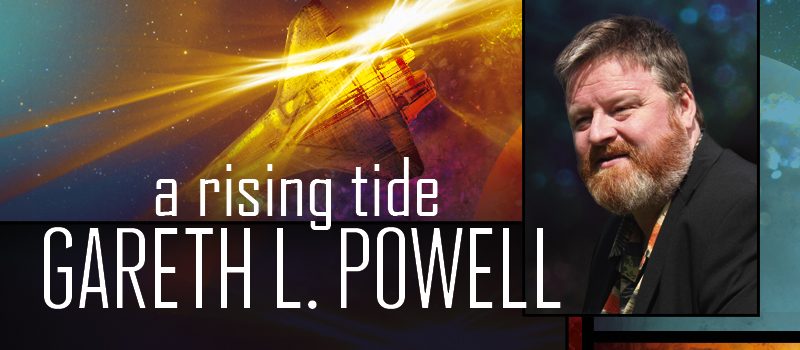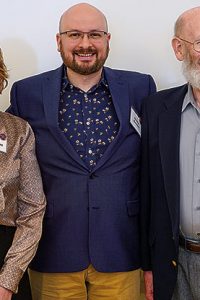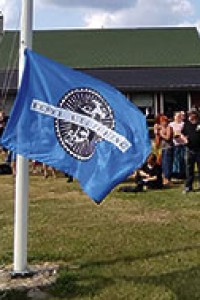Gareth L. Powell: A Rising Tide

Gareth Lyn Powell was born September 3, 1970 in Clifton, Bristol, England; he grew up in Bristol, and lives there still. He studied humanities and creative writing at the University of Glamorgan (later renamed the University of South Wales). He has taught creative writing at various universities. He worked in call centers and in marketing before turning to writing more seriously in 2008.
Powell began publishing SF with “Morning Star” in 2004, and many of his stories appeared in Interzone, including Interzone Readers Poll winner “Ack-Ack Macaque” (2008). Other notable short works include British Science Fiction Association Award finalists “Ride the Blue Horse” (2015) and Ragged Alice (2019). Some of his stories have been collected in The Last Reef (2008) and Entropic Angel and Other Stories (2017). He has also published poetry and essays, and his non-fiction guide About Writing appeared in 2019.
His debut novel Silversands appeared in 2010, followed by The Recollection in 2011. BSFA Award winner Ack-Ack Macaque launched a humorous SF series that continued with Hive Monkey (2013) and Macaque Attack (2014). BSFA Award winner Embers of War (2018) launched a new space opera series, followed by Fleet of Knives (2019) and Light of Impossible Stars (2020).
Excerpts from the interview:
“My parents are both schoolteachers, and my mother taught me to read before I went to school. I was always at the library, always reading; they had a great big sci-fi section there, so I started to read all the Doctor Who novelizations. In those days we didn’t have video players, so once you’d seen an episode on TV, you’d never see it again – but if you had the novelizations, you could read it. I discovered Robert Heinlein there, his younger books, like Have Space Suit – Will Travel, then picked up The Ringworld Engineers by Larry Niven. I was about ten, and that just blew my mind. I read the whole Known Space series off the back of that when I was 12 or 13, which is quite an impressionable age, and obviously I’d grown up with Star Wars and Battlestar Galactica and everything else on the TV. My mother was just happy I was reading. I went through a Michael Moorcock phase at school, and read all the Elric books and Corum and so on, but it never appealed to me in a writing way. I was more interested in sleek, fast things that go at the speed of light than in people going around on horses and hacking at each other with swords. I enjoy fantasy, but it’s never appealed to me to write.
“I always wanted to be a writer. I wrote terrible poetry as a teenager, and a few short stories, and when I was about 15 I won a short story competition at school. The prize was to have your story read by Diana Wynne Jones, and so I went along to have lunch and coffee with her. She went through my story and told me how derivative it was, but she also made some really great points that I’d never thought of, and I still have her handwritten notes at home somewhere in a box. That was a great turning point – sitting with Diana Wynne Jones and being taken seriously at 15.
“After that I went to university and did a humanities degree, but one thread of that degree for three years was creative writing, and I was very lucky that novelist and poet Helen Dunmore was one of the teachers. She taught me more in an afternoon one-on-one session than I learned in the whole of secondary school about writing. The creative writing course at university refused to have anything to do with science fiction. They only wanted literary fiction, so I spent three years trying to write that, and struggling. When I finished, I had the economic reality of needing to get a job with a humanities degree, which doesn’t really qualify you for anything apart from teaching. I knew I wasn’t a born teacher, so I worked in call centers, and worked for ten years as an assistant marketing manager for a large business software company, and then in 2008 I was made redundant just as the economy crashed. I thought, ‘Well, now’s the time to start taking writing seriously.’ I’d had some short stories published in Interzone in 2006 or 2007, and a short story collection came out on the back of that, but that was when I started writing seriously.
“I’d spent years tinkering with this novel called Silversands – I wrote it and rewrote it and rewrote it and rewrote it. The final edit turned out to be around 50,000 words long, so it was quite short, but Christopher Teague from Pendragon Press got in touch with me through Interzone, and it turned out we’d been to the same university. He said, ‘Oh, I’ll publish that for you.’ It was only a 300-copy, limited edition print run from a small press, but it was enough to put me on a few people’s radar. That was 2010, and in 2011 I had my first full-length novel out with Solaris, The Recollection. That’s where the story really starts.
“I’m focusing mostly on novella and novel-length work these days. I wrote a lot of short stories when I was starting out, because they’re a great way to find your voice and to experiment with ideas, but nowadays every idea I get seems to be between 50,000 and 90,000 words long. My novella Ragged Alice was a complete change in genre and change of pace. I was aiming for a Welsh Twin Peaks. My father’s side of the family are all from West Wales, so it’s a culture I had insight into, and I love the rhythms of the speech. I really wanted to get the atmosphere and the Welsh-ness of the place through, without resorting to stereotypes. I was very pleased with how that one came out. I wanted to get the rolling descriptions of Dylan Thomas in there – there’s a Welsh cadence to description that rolls off the tongue, and I think I’ve managed to capture some of that. I wasn’t writing Ragged Alice as horror, but there are definitely supernatural elements. My agent and I agreed that I was going to write a Lee Child, Jack Reacher, internationally bestselling-style thriller, and I went away and accidentally came up with a police procedural set in Aberystwyth that was very much not a Lee Child thriller. I don’t know where the story came from, but a lot of my Welsh background just bubbled up and seeped out. Wales has staggeringly beautiful scenery and mountains and valleys, but at the same time, when it gets to twilight, it can be very eerie, with lines of evergreen trees against the skyline, and the bracken rustling in the wind, and darkness in the valley – the towns are like little islands of light between them. There are standing stones littering the countryside, and lots of history and mythology – it seems right for a horror setting.
“The Ack-Ack Macaque trilogy is very silly and fast moving, so it’s got very stripped-back, lean prose through most of it, which is quite fun to write. With the Embers series, I wanted to take a step up, to write more literary characters in a pulp-SF situation. That works quite well, and seems to have struck a chord with people.
“I have to get involved with my characters. There’s a plot to draw the action along, but I like delving into the people, and who they are, and where they’re broken. I can’t imagine a character until I’ve found a name for them. Once I’ve found the perfect name, then I can start building the character around that. If you call them ‘Sally,’ you have one set of expectations, whereas if you call them ‘Scarlet,’ you have another set. Once I’ve come up with a name, I start building who they are and what I need them to do in the plot, and then I’ll just start writing, and delving into one or two turning points in their lives that have set them on their path. In Embers of War, that part was obvious, because all the characters were affected by one incident in the war, and it was all about how they responded to that experience. There’s a quote in one of the Embers books, where the spaceship Trouble Dog says something about how, ‘All humans are broken, but it’s the places where they’re broken and how they fix themselves that make them who they are.’ That’s how I approach character. Everybody’s got a bit of tragedy in their life, but it’s how we dealt with it that made us who we are today, and that’s what makes the characters three-dimensional on the page.
“Embers of War is about a spaceship called Trouble Dog who took part in a war crime, but her AI is built on cloned human brain tissue, and the trouble with those battleships is that they tend to develop unintended emotions. She’s developed a conscience, so she feels bad, and resigns her commission to join an organization called the House of Reclamation, which is like the coast guard – it’s a rescue organization, so if ships get in trouble or lost, they go out and try to find them and rescue the survivors. She’s trying to do good, and she’s paired up with a captain who fought on the opposite side of the war from her. They’re two lost souls who bond, and there’s a motley crew they pick up along the way. They go out to find this crashed starliner, and there’s a famous poet on board, but the famous poet turns out not to be who she appears. A lot of things that happened in the war come back to haunt them and threaten to kick off a whole new conflict, so Trouble Dog has to remember how to fight. It’s a bit like a Western, with a gunslinger who’s put down his guns and doesn’t want to fight anymore – like Shane or something. It’s also a novel about redemption, found family, and processing grief and guilt. When you’ve done something bad, how do you go on, and what does that make you? It’s quite introspective, but at the same time it’s fast moving, and there are lots of spaceship battles and people diving into the coronas of suns and nuclear warheads going off like firecrackers, so it’s an interesting mix.”
Interview design by Francesca Myman. Photo by Arley Sorg.
Read the full interview in the March 2020 issue of Locus.
 While you are here, please take a moment to support Locus with a one-time or recurring donation. We rely on reader donations to keep the magazine and site going, and would like to keep the site paywall free, but WE NEED YOUR FINANCIAL SUPPORT to continue quality coverage of the science fiction and fantasy field.
While you are here, please take a moment to support Locus with a one-time or recurring donation. We rely on reader donations to keep the magazine and site going, and would like to keep the site paywall free, but WE NEED YOUR FINANCIAL SUPPORT to continue quality coverage of the science fiction and fantasy field.








